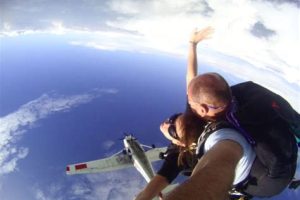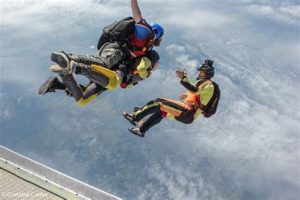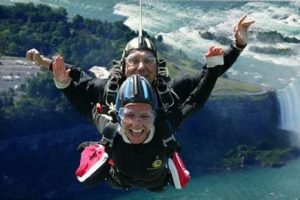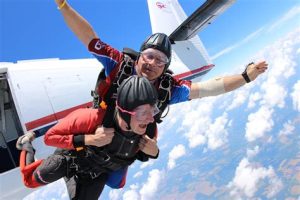Table of Contents
Discover the adrenaline-fueled world of skydiving with our guide comparing tandem skydiving and solo jumps. Learn about the thrill of tandem jumps, where you’ll be securely attached to an experienced instructor. Alternatively, explore the freedom and challenge of solo jumps, where you’ll undergo comprehensive training and take control of your own descent. Find out which option suits your adventurous spirit and take the plunge into the exhilarating world of skydiving.
Are you ready to take your love for adventure to new heights? If you’ve ever considered skydiving, you might be faced with a tough decision: should you opt for the thrill of tandem skydiving or take on the challenge of solo jumping? Both options offer unique experiences, but each comes with its own set of advantages and considerations. In this article, we will explore the exhilarating world of skydiving, comparing the tandem and solo approaches to help you make an informed choice that suits your preferences and level of expertise. So, buckle up, as we dive into the exciting realm of tandem skydiving versus solo!
The Thrill of Tandem Skydiving
Skydiving is a thrilling experience that offers an unparalleled rush of adrenaline. Whether you are a first-time jumper or an experienced skydiver, the decision to go tandem or solo can be a tough one to make. Both options have their own set of benefits and considerations. In this article, we will explore the differences between tandem skydiving and solo jumps to help you make an informed decision.
The Sense of Freedom in Solo Skydiving
Solo skydiving allows you to take full control of your jump and experience the ultimate sense of freedom. As a solo jumper, you are solely responsible for your safety and navigation throughout the jump. This level of independence can be empowering and enhance the overall thrill of the experience.
Building Trust with Tandem Skydiving
One of the main advantages of tandem skydiving is the built-in trust factor. When you opt for a tandem jump, you are connected to a highly-trained instructor who will guide and support you throughout the entire process. This allows beginners to enjoy the thrill of skydiving without having to worry about the technical aspects or decision-making during the jump.
Mastery and Skill Development in Solo Skydiving
Solo skydiving requires a greater level of mastery and skill development. As a solo jumper, you must undergo extensive training and gain proficiency in various techniques such as canopy control and emergency procedures. This journey of skill development can be highly rewarding and provide a deep sense of accomplishment.
Accessibility for Beginners with Tandem Skydiving
Tandem skydiving is the perfect option for beginners who want to experience the thrill of skydiving without the extensive training requirements. With minimal instruction, you can enjoy the breathtaking views and adrenaline rush while your instructor takes care of the technical aspects. This accessibility makes tandem skydiving an ideal choice for those looking for a one-time adventure.
Community and Camaraderie in Solo Skydiving
Solo skydiving opens doors to a vibrant community of like-minded individuals who share a passion for the sport. It offers opportunities to connect with fellow jumpers, participate in group jumps, and learn from experienced skydivers. The camaraderie built within the solo skydiving community adds an extra dimension of enjoyment to the overall experience.
Cost Considerations of Tandem Skydiving
Tandem skydiving generally comes at a lower cost compared to solo jumps. As a first-time jumper, you only need to pay for the experience itself, as the instructor handles the technical aspects. This affordability makes tandem skydiving a more accessible option for those on a budget or simply looking to try skydiving once.
Investment in Equipment for Solo Skydiving
Solo skydiving requires a greater investment in equipment. As a solo jumper, you will need to purchase or rent your own parachute, altimeter, and other gear necessary for a safe jump. This initial investment can be relatively high but provides the flexibility to pursue solo jumps whenever you desire.
The Adrenaline Rush of Tandem Skydiving
Tandem skydiving offers an intense adrenaline rush from the moment you exit the aircraft. The initial freefall, reaching speeds of up to 120mph, coupled with the breathtaking views, creates an unforgettable experience. The rush of adrenaline is amplified by the fact that you are experiencing it alongside an experienced instructor.
The Solo Self-Achievement of Skydiving Solo
While tandem skydiving provides an incredible thrill, nothing quite compares to the self-achievement of completing a solo skydive. The feeling of conquering your fears and taking charge of every aspect of the jump is unparalleled. It is a testament to your personal growth and ability to overcome challenges.
Choosing Between Tandem and Solo Skydiving
Ultimately, the choice between tandem and solo skydiving depends on your preferences, goals, and level of commitment. If you are seeking an accessible, adrenaline-fueled adventure without the need for extensive training, tandem skydiving is a fantastic choice. On the other hand, if you are looking to develop your skills, enjoy a sense of independence, and become part of a thriving community, solo skydiving may be the path for you. Whichever option you choose, the experience of soaring through the sky and defying gravity will undoubtedly leave you with memories to last a lifetime.
Tandem Skydiving vs Solo: Instructions and Guidelines
Welcome to a comparative guide on tandem skydiving and solo skydiving, highlighting the differences, benefits, and considerations for each option. This guide aims to help you make an informed decision based on your preferences and experience level.
Freefall Experience
Choosing tandem skydiving offers an excellent opportunity to enjoy the thrilling experience of freefall in the company of a certified instructor, allowing you to focus solely on the sensation of flying through the sky without worrying about the technical aspects of the jump. The instructor takes care of all the necessary procedures, ensuring a safe and enjoyable experience for you.
Safety Factors
When it comes to safety, both tandem skydiving and solo skydiving have their unique protocols. Tandem skydiving places the responsibility of safety largely on the instructor, who is thoroughly trained to handle any contingencies during the jump. They have the expertise to assess the conditions, manage emergencies, and ensure a smooth landing. On the other hand, solo skydiving requires you to undergo rigorous training and gain expertise in maneuvering your parachute to ensure a safe landing. You must be knowledgeable about emergency procedures and capable of making split-second decisions to mitigate any potential risks.
Training Requirements
Opting for tandem skydiving requires minimal training, as the instructor takes care of all technical aspects of the jump. They will provide you with a brief orientation, ensuring you understand the basics and feel comfortable before the jump. However, if you choose solo skydiving, you must undergo a comprehensive training program that covers parachute handling, emergency procedures, and proper body positioning during the jump. This training ensures that you are well-equipped to handle the challenges that arise during a solo skydive.
Level of Control
Tandem skydiving allows you to enjoy the incredible sensation of freefall while relinquishing control to the instructor, who handles all the technicalities of the jump. This provides a sense of security and allows you to focus on the experience itself. Solo skydiving, on the other hand, grants you complete control over your jump, providing a sense of accomplishment and independence as you navigate your own path through the sky. You have the freedom to decide your trajectory, perform maneuvers, and truly immerse yourself in the sport.
Skill Acquisition and Progression
While tandem skydiving focuses on enjoyment and providing a taste of skydiving, solo skydiving offers a platform for skill acquisition and progression. Solo skydivers have the opportunity to gain expertise, learn advanced maneuvers, and explore various styles of skydiving, such as formation skydiving or canopy piloting, as they progress in their skydiving journey. Solo skydiving allows you to continuously challenge yourself and improve your skills, leading to a more fulfilling and rewarding experience.
Risk Factors
As with any adventure sport, skydiving entails inherent risks. Tandem skydiving carries a relatively lower risk due to the constant presence of an instructor, who ensures the safety and proper execution of the jump. They are trained to handle emergencies and mitigate risks effectively. However, solo skydiving involves a higher level of risk, as you are solely responsible for your own safety. It requires a thorough understanding of safety protocols and emergency procedures, as well as the ability to make split-second decisions in high-pressure situations. Proper training and continuous practice are essential to minimize risks in solo skydiving.
Budget Considerations
Typically, tandem skydiving often involves a lower initial investment compared to solo skydiving. Solo skydiving requires substantial training costs as well as licensing fees, equipment purchase or rental costs, and ongoing expenses for jumps. Therefore, it is essential to consider your budget when deciding between tandem and solo options. However, keep in mind that the investment in solo skydiving offers a more comprehensive and immersive experience, allowing you to explore the sport in-depth.
Remember, whether you choose tandem skydiving or decide to embark on the path of solo skydiving, always prioritize your safety, consult with experienced professionals, and make sure to thoroughly read and follow the guidelines provided by the skydiving center you choose. Safe jumps and have a fantastic skydiving experience!
Point of View: Tandem Skydiving Vs Solo
- Tandem Skydiving:
- Tandem skydiving offers a thrilling and adrenaline-pumping experience for individuals who want to try skydiving but have no previous training or experience.
- The instruction voice and tone for tandem skydiving should be reassuring, calming, and encouraging, as it is crucial to alleviate any anxiety or nervousness that first-time jumpers may have.
- The instructor should use clear and concise instructions, ensuring that the tandem jumper understands the necessary safety procedures and body positions during the jump.
- The tone should convey a sense of excitement and adventure while emphasizing the importance of following instructions to ensure a safe and enjoyable experience.
- The instruction voice should also offer constant reassurance, reminding the tandem jumper that they are in capable hands and that their safety is the top priority.
- Using positive reinforcement and motivational language can help boost the confidence of the tandem jumper, making them feel more at ease throughout the entire skydiving process.
- Solo Skydiving with Instructions:
- Solo skydiving with instructions is designed for individuals who have completed the necessary training and are qualified to jump without the assistance of an instructor.
- The instruction voice and tone for solo skydiving should be authoritative, firm, and focused on safety, as the responsibility lies solely on the individual to execute the jump correctly.
- Clear and precise instructions should be provided, emphasizing the importance of proper equipment usage, body positioning, and parachute deployment.
- The tone should convey a sense of seriousness and caution, highlighting that any negligence or failure to follow instructions can have severe consequences.
- The instruction voice should also be informative, providing any necessary updates on weather conditions, air traffic, or other potential hazards that may affect the jump.
- Using assertive language and ensuring that the solo jumper understands the gravity of the situation can help instill a sense of responsibility and focus for a successful solo skydiving experience.
Thank you for taking the time to read our blog post on Tandem Skydiving vs Solo. We hope that you have found the information and insights provided to be helpful in making your decision on which experience to pursue. Before we conclude, we would like to provide you with some final thoughts and considerations to keep in mind.
If you are a first-time skydiver or someone who prefers a more relaxed and guided experience, then tandem skydiving may be the ideal choice for you. With a tandem jump, you will be attached to an experienced instructor who will take care of all the technical aspects, allowing you to fully enjoy the thrill of freefall. This is a great option for those who want to skydive without having to go through extensive training or acquire a license. Additionally, tandem jumps provide an excellent opportunity to take in the breathtaking views from high above the ground, as you will have more time to appreciate the scenery during the descent.
On the other hand, if you are seeking a deeper sense of adventure and independence, solo skydiving might be the perfect fit. While it requires a greater commitment in terms of training and preparation, the rewards are immeasurable. Solo skydiving grants you the freedom to control your own destiny, making every jump a truly personal and empowering experience. The process of earning your skydiving license can be incredibly fulfilling, as you develop a comprehensive understanding of the sport and gain the skills necessary to jump solo. You will also have the opportunity to join a community of passionate skydivers, forming lifelong friendships and connections.
In conclusion, both tandem skydiving and solo skydiving offer their own unique advantages and appeal to different individuals. It ultimately comes down to your personal preferences and goals. Whether you choose the thrilling tandem experience or decide to embark on the solo skydiving journey, we are confident that you will have an unforgettable adventure that will stay with you for a lifetime. So, take that leap of faith and let the skies be your playground!
Thank you once again for visiting our blog. We hope you found the information provided to be valuable and insightful. If you have any further questions or would like to share your own skydiving experiences, please feel free to leave a comment below. Safe travels and blue skies!
Video Tandem Skydiving Vs Solo
People also ask about Tandem Skydiving Vs Solo:
1. Is it safer to skydive solo or tandem?
Tandem skydiving is generally considered to be safer than solo skydiving, especially for first-time jumpers. In tandem skydiving, you are securely attached to an experienced instructor who handles all the technical aspects of the jump, ensuring a safe and controlled descent. Solo skydiving requires extensive training and experience, as you are responsible for deploying your own parachute and navigating the landing. Therefore, if you are new to skydiving, tandem skydiving is recommended for a safer and more enjoyable experience.
2. Can I go solo skydiving without any prior experience?
No, you cannot go solo skydiving without prior experience. Solo skydiving requires proper training and certification. Most skydiving centers offer courses that teach you the necessary skills and techniques to safely jump alone. These courses typically include ground training, practice jumps, and evaluations by certified instructors. It is essential to acquire the necessary knowledge and experience before attempting a solo skydive to ensure your safety.
3. What are the benefits of tandem skydiving?
Tandem skydiving offers several benefits for beginners:
- Increased safety: You are attached to an experienced instructor who manages all the technical aspects of the jump, allowing you to enjoy the experience without worrying about the details.
- Less training time: Unlike solo skydiving, tandem skydiving requires minimal training. You receive brief instructions on body positioning and safety procedures before the jump, making it accessible to first-time jumpers.
- More comfort: Tandem skydiving allows you to fully experience the thrill of freefall and the beauty of the sky without having to focus on the technical aspects. You can simply enjoy the ride!
4. Can I still experience freefall during a tandem skydive?
Absolutely! During a tandem skydive, you can experience the exhilarating freefall just like in a solo skydive. The only difference is that you are securely attached to an instructor who ensures your safety and manages the parachute deployment. You get to enjoy the incredible sensation of terminal velocity and the breathtaking views during the descent.
5. Is there an age limit for tandem or solo skydiving?
The minimum age requirement for both tandem and solo skydiving varies by country and skydiving center. In most places, the minimum age for tandem skydiving is 18 years old, while solo skydiving requires you to be at least 16 or 18 years old, depending on the location. Additionally, some centers may have upper age limits or require a doctor’s approval for older individuals. It’s best to check with your local skydiving center for their specific age restrictions and requirements.






